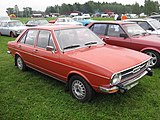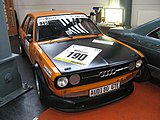Audi 80 B1
| Audi | |
|---|---|
|
Audi 80 (1972-1976)
|
|
| 80 B1 | |
| Production period: | 1972-1988 |
| Class : | Middle class |
| Body versions : | Limousine , station wagon |
| Engines: |
Petrol engines : 1.3-1.6 liters (40-81 kW) |
| Length: | 4200 mm |
| Width: | 1600 mm |
| Height: | 1360 mm |
| Wheelbase : | 2470 mm |
| Empty weight : | 835-880 kg |
| Previous model | Audi F103 |
| successor | Audi 80 B2 |
The Audi 80 B1 (internal designation: Type 80 , from 1976: Type 82 ) is a sedan from Audi NSU Auto Union AG and came onto the German market in early summer 1972 as the successor to the Audi F103 . It was not until March 1973 that Audi officially presented it at the Geneva Motor Show . The Audi 80 also provided the basis for the VW Passat , offered from May 1973 , which was only built with a hatchback and as a station wagon.
The two- or four-door car with a longitudinally installed four-cylinder gasoline engine and front-wheel drive was replaced by the Audi 80 B2 with the same technology in late summer 1978 .
Model history
Type 80 (1972–1976)
The first Audi 80 went on sale in June 1972. His modern concept with the newly developed engines should point the way for the Audi and VW models of the 1970s. The newly designed engine ( EA827 ) with an overhead camshaft and bucket tappets also had an intermediate shaft to drive the distributor and the gear oil pump . Because the car was very light (the 100 hp version weighed only 900 kg) and the engines were very economical for the time, the Audi 80 was a great sales success after the first oil crisis in 1973 .
With its rear-engined Beetle-style vehicles, VW got into a serious crisis in the early 1970s, which it was able to overcome with new water-cooled models with Audi technology. The first VW model with Audi engines was the VW Passat presented in the spring of 1973 . Up to the B-pillar, the Audi 80 B1 and the VW Passat B1 were essentially identical. In addition to the Passat, the Audi engines were also used in the VW Scirocco and VW Golf (both from spring 1974) and from then on formed the basis of all engines in the Volkswagen Group for many years. The Group's current engines, such as the EA888, also have the cylinder spacing of the EA827, with which they otherwise have no structural features in common, in order to be able to use the established cycle lines.
On the Passat, not only the engines but also a large part of the body were taken over from Audi. The first Passat was in fact the hatchback version of the Audi 80, which in turn was only available with a notchback . Except for the hatchback, the rectangular headlights, a slightly modified rear axle suspension and other small body details, the VW Passat was identical to the Audi 80. In the USA the Audi 80 was sold as Audi Fox , a station wagon variant was called the Audi Fox Station Wagon . This was basically identical to the VW Passat Variant, but was produced in Ingolstadt.
In a slight revision in the spring of 1974, the aluminum radiator grille was replaced by one made of plastic. Furthermore, the bumpers were no longer pulled around the fenders, but rather provided with black plastic caps at the corners.
The Audi 80 was also assembled at the Volkswagen plant in Wolfsburg
Type 82 (1976–1978)
In August 1976 there was a major facelift , the internal designation was now Type 82 .
The body was adapted to the new Audi 100 at the front and rear , the engine range continued to include the engines of the Type 80 with 40.5 kW to 81 kW. The 55 kW variant now had 1.6 liters instead of 1.5 liters due to US emissions regulations. The models with 55 kW and 63 kW (85 PS) could now be combined with several equipment lines, the model names were accordingly S / LS / GLS.
The model for the US market was still known as the Audi Fox ; Type 82 was also offered as a variant in the station wagon version . Such a station wagon has been included in the collection of Audi AG's in-house museum since 2012. While the Fox was marketed through the Porsche + Audi sales channel, its sister model, the VW Dasher Variant, entered the US market through the VW sales channel. The European Audi 80 GTE was called the Audi Fox GTI in the USA.
However, the Audi 80 Station Estate was still available in the UK and South Africa . In small numbers, this version was provided with an applied wooden film on the side of the vehicle. For the VW Passat B1, which was manufactured in Brazil until 1988, VW took over the front section of the Type 82, only the Audi logo was replaced by a VW emblem.
In Germany, from January 1978, the special model “Millionär”, exclusively in silver metallic, was available. Shortly before the end of the series, the "Super 80" was presented, which is available with GTE equipment in the performance levels of 55, 75 or 85 hp and in three colors (red, blue and silver metallic) and is limited to 750 pieces each was. All "Super 80" were only produced in August 1978 shortly before the switch to the successor model.
After 1,103,766 units were produced, the Audi 80 B1 was finally replaced by the Audi 80 B2 (Type 81) at the end of August 1978 . Since the B1 was extremely successful on the market, the B2 was based on the technical layout of the B1, but with an increase in the external dimensions.
variants
| model | Engine power |
|---|---|
| Audi 80, Audi 80 L (1972–1978) | 40 kW (55 PS) |
| Audi 80 S (1972–1975) Audi 80 LS (1972–1978) Audi 80 GLS (1975–1978) |
55 kW (75 PS) |
| Audi 80 GL (1972–1975) Audi 80 LS (1976–1978) Audi 80 GLS (1976–1978) Audi 80 GLX (1978) |
63 kW (85 PS) |
| Audi 80 GT (1973-1975) | 74 kW (100 PS) |
| Audi 80 GTE (1975–1978) | 81 kW (110 PS) |
- "L", "GL" and "GT" designate the equipment variant, "S" and "E" the engine.
Technical specifications
| 80 (L) | 80 S, LS | 80 GL | 80 GT | 80 S, LS, GL 1 | 80 GL 2 | 80 GTE | ||
|---|---|---|---|---|---|---|---|---|
| Engine type | VW EA827 | |||||||
| Engine type |
Water-cooled four-cylinder four-stroke Otto -line engine , mounted longitudinally by 20 degrees to the right inclined five bearings crankshaft , overhead camshaft via toothed belt driven pressure lubrication (74- and 81-kW motor: aluminum oil pan with cooling fins without a separate oil cooler, such as in golf / Scirocco GTI / GLi) |
|||||||
| Mixture generation | Solex downdraft carburetor with automatic starter | Downdraft register carburetor with automatic start | Solex downdraft carburetor with automatic starter | Downdraft register carburetor with automatic start | Bosch K-Jetronic intake manifold injection | |||
| Displacement | 1297 cc | 1471 cc | 1588 cc | |||||
| Bore × stroke | 75.0 x 73.4 mm | 76.5 x 80.0 mm | 79.5 x 80.0 mm | |||||
| Max. Output kW (PS) at 1 / min |
40 (55) 5500. |
55 (75) 5800. |
63 (85) 5800 |
74 (100) 6000 |
55 (75) 5600. |
63 (85) 5600 |
81 (110) 6100. |
|
| Max. Torque Nm at 1 / min | 92 at 2500 | 114 at 3500 | 121 at 4000 | 131 at 4000 | 118 at 3200 | 124 at 3200 | 137 at 5000 | |
| transmission |
Fully synchronized four-speed manual transmission behind the front axle,
a. W. three-speed automatic transmission with hydraulic converter (only 55 and 63 kW) |
|||||||
| drive | Front wheel drive | |||||||
| steering | Rack and pinion steering , negative scrub radius | |||||||
| Front axle | MacPherson struts , wishbones, anti-roll bars , disc brakes | |||||||
| Rear axle |
Torsion crank axle , Panhard rod for lateral guidance, hydraulic telescopic shock absorbers with coil springs, drum brakes , Ø 180 mm (with automatic transmissions, GT and GTE: Ø 200 mm) |
|||||||
| body | self-supporting sheet steel body | |||||||
| Top speed in km / h |
147 | 160 155 3 |
168 163 3 |
173 | 160 156 3 |
170 166 3 |
181 | |
1 from 1976 as S, LS, GLS
2 from 1976 as LS and GLS
3 with automatic transmission
Web links
- Audi Germany
- Link catalog on the topic of Audi 80, 90, 100 and 200 models at curlie.org (formerly DMOZ )
- Everything about Audi 1972–1986
Individual evidence
- ↑ https://www.focus.de/auto/neuheiten/mittelklasse/mehr-suv-und-elektroautos-neuer-auto-hammer-vw-stell-den-passat-ein_id_9874856.html VW is apparently discontinuing its legendary family carriage, in: Focus online , accessed on November 8, 2018













